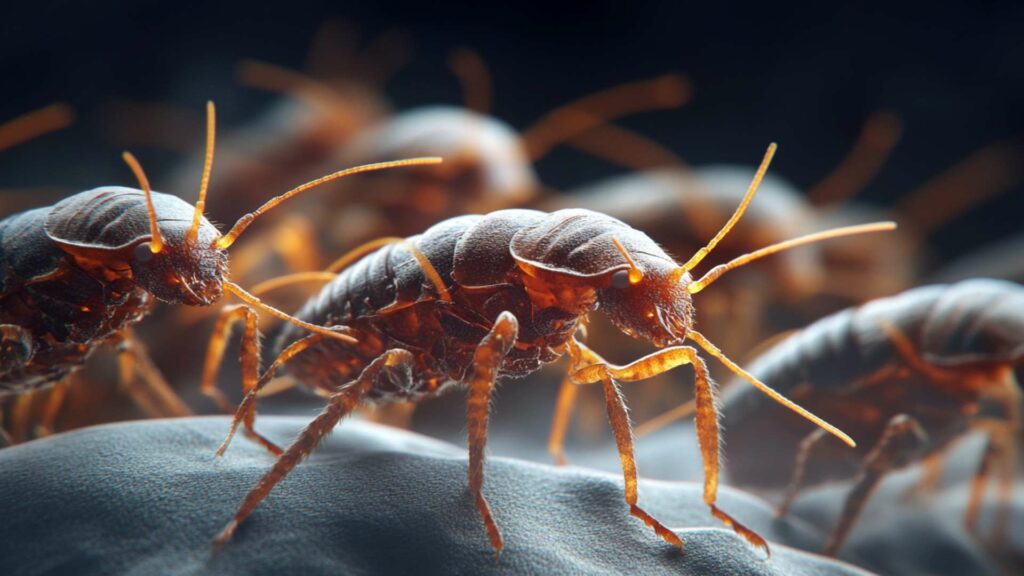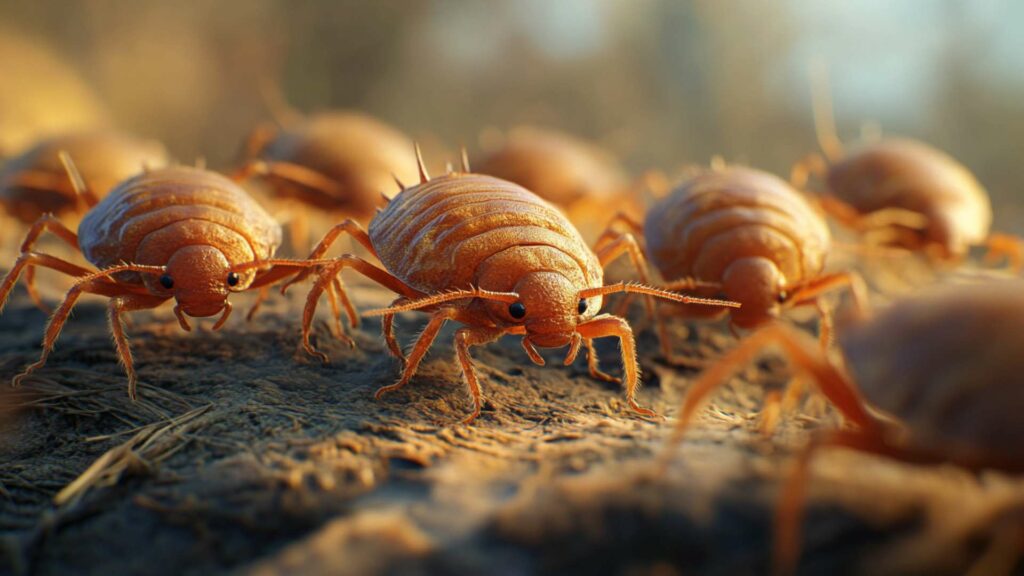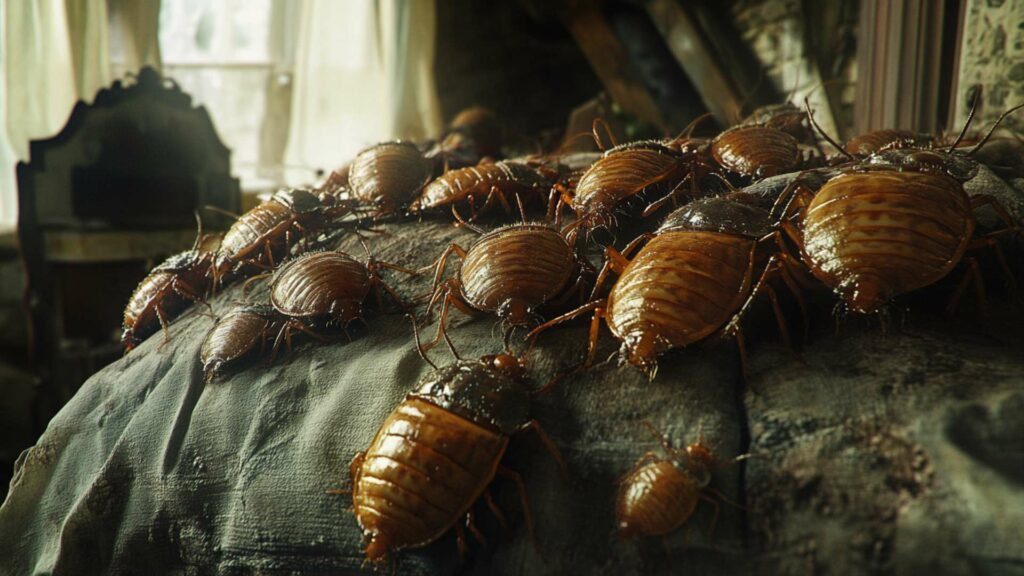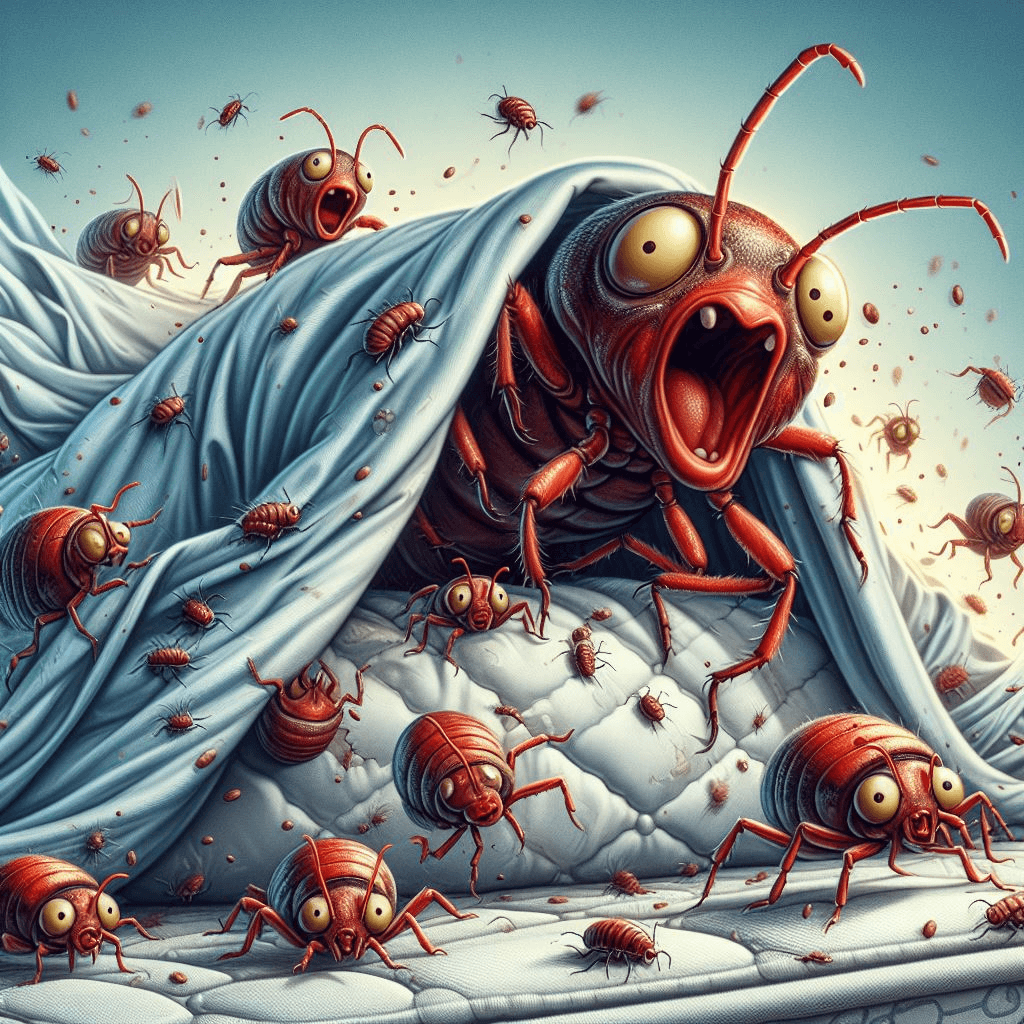Bed Bug Infestation Signs and Detection
The Sneaky Intruders that Hide in Plain Sight
Picture this: you’re snuggled up in bed after a long day, ready to drift off into dreamland, when suddenly, an unwelcome visitor decides to join you. No, we’re not talking about your furry friend snuggling up for a cozy nap; we’re talking about those pesky, blood-sucking creatures known as bed bugs.
Bed bug infestations have become a growing concern in recent years, infiltrating homes, hotels, and even public spaces. These tiny, elusive insects are experts at hiding in the tiniest crevices and emerging only at night to feast on unsuspecting humans.
But fear not! In this comprehensive guide, we will equip you with the knowledge needed to identify the early warning signs of a bed bug problem and take action before it gets out of hand.
Immerse yourself in the realm of our top-tier bed bug control and treatment services! Unveil the exceptional capabilities of our professional solutions in effectively addressing and eradicating your bed bug infestation. Click here to delve deeper into the details of our specialized bed bug control and treatment services and acquire valuable information!
The Importance of Early Detection: Don’t Let Them Bite!

Early detection is key when it comes to dealing with these stealthy pests. The sooner you spot the signs of a bed bug infestation, the easier it is to nip it in the bud and prevent further spread throughout your home or hotel room. Ignoring or delaying treatment can lead to a full-blown infestation that requires professional extermination.
One of the most alarming aspects of bed bugs is their ability to reproduce rapidly. A single female bed bug can lay hundreds of eggs during her lifetime!
These eggs hatch into tiny nymphs that grow into adult bed bugs within weeks. So what begins as a minor issue can quickly escalate into an all-out battle against these reddish-brown insects.
Furthermore, addressing an infestation of young bed bugs early reduces the risk of bites and potential health complications. While some individuals may not experience any skin reactions from bed bug bites, others may develop itchy welts, rashes, or even secondary infections from scratching.
By taking proactive measures to detect and treat bed bug bites and bugs early on, you can protect yourself and your loved ones from these unwelcome intruders. In the upcoming sections of this article, we’ll dive into the physical signs of bed bug infestations, how to identify their bites, and where these crafty critters love to hide.
Armed with this knowledge, you’ll be well-prepared to take control and get rid of bed bugs and your living space of these pesky pests. So let’s roll up our sleeves and get started on the journey towards a bed bug-frebed-bug-freee existence!
Visible Bed Bugs: The Pesky Intruders of Your Sanctum
How to Check for Bed Bugs in Your Home
Detecting bed bugs early is crucial for effective control. Our article on how to check for bed bugs in your home provides a step-by-step guide to help you identify potential infestations. Learn about common hiding spots, signs of their presence, and inspection techniques to conduct a thorough examination of your living space. Stay vigilant and protect your home from bed bug infestations.
Signs of a Bed Bug Infestation
Recognizing the signs of a bed bug infestation is key to prompt action. In our comprehensive article on signs of a bed bug infestation, we highlight the indicators that bed bugs leave behind. From identifying bite marks and bloodstains to finding shed skins and fecal stains, understanding these signs will help you confirm the presence of bed bugs and seek appropriate treatment. Stay informed and act swiftly to tackle infestations.
How to Identify Bed Bug Bites
Bed bug bites can be distressing, but accurately identifying them is essential. Our article on how to identify bed bug bites provides insights into the characteristics and appearance of bed bug bites. Discover the distinguishing factors between bed bug bites and bites from other insects, and learn how to differentiate them from skin conditions. Gain the knowledge to properly identify bed bug bites and seek appropriate care.
How to Spot Bed Bugs in Your Bedding
Bed bugs have a preference for hiding in bedding, making it important to know how to spot them in this crucial area. Our informative article on how to spot bed bugs in your bedding offers practical tips for thorough inspections. Learn where to look for bed bugs, including seams, folds, and mattress crevices. Understand the visual cues and signs that indicate the presence of these pests in your bedding.
How to Find Bed Bugs in Furniture
Bed bugs can infest furniture, making it crucial to know how to find them in these items. Our article on how to find bed bugs in furniture provides insights into the common hiding spots in different types of furniture. Learn how to conduct meticulous inspections, including checking seams, joints, and crevices. Stay proactive and equipped with the knowledge to identify bed bugs in your furniture.
How to Detect Bed Bugs in Hotel Rooms
Travelers often encounter the risk of bed bugs in hotel rooms. Our article on how to detect bed bugs in hotel rooms equips you with the tools to protect yourself during your stay. Learn how to conduct a thorough room inspection upon arrival, identify signs of infestations, and take proactive measures to minimize the chances of bringing bed bugs back home with you. Travel with confidence and stay bed bug-free.
A closer look at adult bed bugs and their undeniable presence
When it comes to identifying a bed bug infestation, one of the most obvious signs is spotting the culprits: skin bed bugs themselves. Adult bed bugs are reddish-brown insects about the size of an apple seed, with a flat and oval-shaped body. Their appearance can be likened to tiny, blood-sucking vampires that disturb your peaceful slumber.
Despite their minuscule size, they can be visible to the naked eye. These nocturnal creatures have six legs and antennae that are designed for seeking out their favorite sustenance: human blood.
They are expert hiders and can squeeze into cracks as thin as a credit card during daylight hours, making them difficult to spot. However, if you’re lucky (or rather unlucky), you might catch sight of these sneaky sleep disruptors scurrying around your mattress seams, behind headboards, or along baseboards.
Identifying Nymphs and Eggs: The Younger Generation of Bed Bugs
Adult bed bugs may steal the spotlight in terms of visibility, but nymphs (immature bed bugs) and eggs also play significant roles in confirming an infestation. Nymphs are smaller than adults and go through several stages before reaching maturity.
Initially, translucent or pale yellow skins shed by nymphs can often be found near harborage sites. These shed skins resemble tiny exoskeletons that they leave behind as they grow.
Additionally, uncovering bed bug eggs is another telltale sign of early signs of bed infestation. These tiny white ovals are about 1mm long—almost similar in size to a pinhead—and tend to be clustered together in concealed locations near where humans rest or sleep.
Common hiding spots include crevices in furniture joints, seams of mattresses, or even behind wall hangings. Identifying these eggs is crucial as it allows for targeted treatment to prevent the next generation from hatching and continuing the infestation cycle.
Fecal Stains and Blood Spots: Clues Left Behind by Pesky Pests
While bed bugs themselves might not always be visible, their excrement certainly can be. Fecal stains and blood spots are another key indicator of their presence.
After feeding on human blood, bed bugs excrete digested blood in the form of dark fecal stains that resemble small ink spots on bedding or furniture. These fecal stains often have a distinct appearance—a combination of reddish-brown color and a slightly darkened center due to the concentration of dried blood.
It’s important to note that these marks may smear if rubbed with a damp cloth or water, setting them apart from other common stains like those caused by food or drink spills. Differentiating bed bug fecal stains from other blemishes is vital in accurately identifying an infestation.
Knowing what to look for can help you take prompt action to protect your sleeping sanctuary kill bed bugs and prevent further sleep deprivation caused by these unwelcome visitors. In the next section, we’ll explore another aspect of uncovering a bed bug infestation: analyzing the characteristics of bites and skin reactions they cause.
Bites and Skin Reactions

Characteristics of Bed Bug Bites: Tiny Terrors on Your Skin
Ah, the notorious bed bug bite—the unwelcome souvenir from these tiny terrors. Bed bug bites are small, red, and raised welts that can cause quite a commotion on your skin. These bites are typically painless at first but soon turn into an itchy nightmare.
One characteristic of bed bug and spider bites is their tendency to form clusters or straight lines. This distinct pattern distinguishes them from other insect bites.
Appearance on Different Skin Types: A Prickly Predicament
Just like humans come in different shapes and sizes, so do our skin reactions to bed bug bites. People with more sensitive skin may experience larger welts or even blisters around the bed bugs bite area.
On the other hand, those with less sensitive skin might only notice small, red dots resembling mosquito bites. Darker-skinned individuals may see bed bug bite marks appear as dark spots or patches.
Common Locations for Bites: Their Favorite Snacking Spots
Bed bugs are opportunistic feeders—they’ll snack on any exposed skin they can find while you’re peacefully snoozing away. Common areas for bed bug bites include the face (particularly around the nose and mouth), neck, arms, and legs. However, don’t be surprised if they venture to less conventional areas like your back or buttocks if left exposed during slumber.
Allergic Reactions and Secondary Infections: When Bites Become More Than an Irritation
For most people, bed bug bites are merely annoying—an itch that demands scratchy attention. However, in some cases, these pesky punctures can lead to allergic reactions or secondary infections due to excessive scratching.
Allergic reactions might manifest as severe itching, swelling, or even difficulty breathing. In rare instances, persistent scratching can break the skin’s protective barrier, leaving it vulnerable to infection.
If you experience any unusual symptoms beyond the typical itching and redness associated with bed bug bites, seek medical attention promptly to prevent further complications. So be vigilant and pay close attention to any bites or skin reactions that might be caused by these unwelcome intruders.
Understanding the characteristics of bed bug bites, their appearance on different skin types, and common bite locations can help you identify a potential infestation early on. Remember, your comfort and health are paramount—don’t hesitate to seek medical assistance if needed!
Odor Detection Methods
The Distinct Odor Profile of Bed Bugs
When it comes to detecting the presence of bed bugs, our olfactory senses play a crucial role. These pesky pests emit a unique scent that can be described as a combination of coriander and moldy raspberries. This distinct odor is often compared to the smell of rotting berries or a musty odor.
If you suspect bed bugs in your home or hotel room, be on the lookout for this particular aroma. The reason behind this peculiar fragrance lies in the secretions produced by bed bugs.
These insects release pheromones as well as chemicals found in their saliva, which contribute to the distinctive smell. The odor is strongest in areas where there’s a significant infestation or aggregation of bed bugs.
Techniques for Detecting Bed Bug Odors
One effective method for detecting where bed bugs feed on bug odors is through the use of trained dogs. Certain dog breeds possess an exceptional sense of smell and can be trained to identify specific scents, including that emitted by bed bugs.
These canine detectives can pinpoint areas where bed bugs are present, even if they’re hiding out of sight. Their keen noses make them invaluable assets in pest control efforts.
However, if you don’t have access to trained dogs, there are still ways for humans to detect these odors themselves. One approach is conducting thorough inspections with your nose close to potential hiding spots such as mattresses, box springs, and furniture seams.
The distinct scent should become more prominent as you get closer to any infested areas. Another technique involves using your sense of smell after creating conditions that prompt the release of bed bug odors.
For instance, placing heated traps or homemade DIY interceptors around suspected areas can lure out these insects and intensify their scent emission. Remember that while odor detection methods can be useful, they should be accompanied by other signs of infestation for a more comprehensive confirmation.
The unique scent emitted by bed bugs serves as a key indicator of their presence. Detecting this distinct aroma can help in identifying and confirming an infestation.
Whether through the use of trained dogs or employing your keen sense of smell, these odor detection methods provide crucial assistance in tackling bed bug problems. So, stay vigilant and follow your nose to achieve an effective solution to rid one bed bug yourself of these bothersome pests.
Telltale Bed Bug Hiding Spots
Common hiding spots in bedrooms

Where do these pesky bed bugs hide and lurk? Bed bugs are notorious for their ability to hide in various nooks and crannies, making detection a challenging task.
In bedrooms, they tend to gravitate towards specific hiding spots where they feel safe and undisturbed. One of their favorite hideouts is within the cozy confines of mattresses, box springs, and bedding.
These pests can squeeze into tiny crevices or seams, making it nearly impossible to spot them with the naked eye. Therefore, it is crucial to carefully inspect these areas when looking for signs of bed bug infestation.
Another common hiding spot for bed bugs in bedrooms is furniture seams, cracks, and crevices. They thrive in the narrow gaps between wooden boards or cushions, where they can easily remain undetected for extended periods.
These sneaky insects have flat bodies that allow them to squeeze into seemingly inaccessible areas. So don’t forget to scrutinize every inch of your furniture when attempting to detect an infestation.
Unusual hiding spots outside bedrooms
Bed bugs aren’t just bedroom enthusiasts! While bedrooms may be their primary playgrounds, bed bugs are not limited by walls or boundaries; they can wander outside this realm too! You might be surprised by some unusual places these little bloodsuckers can call home.
One such unexpected hiding spot is electrical outlets and wall voids. Their flattened bodies enable them to slip through the tiniest openings around electrical sockets or cracks in walls—places you wouldn’t typically associate with pesky bed bug infestations.
Another surprising hideout is right under your nose—or more accurately—your clothes! Bed bugs are known hitchhikers and can latch onto clothing, bags, or luggage without you even realizing it.
They are masters of camouflage and can easily blend into fabrics, making it difficult to spot them. That’s why it’s crucial to inspect your belongings thoroughly after traveling or being in areas where bed bugs may be present.
No matter where bed bugs choose to hide, it is vital to understand their preferences in order to effectively detect and eliminate them from your living spaces. [Include a transition sentence here]
Visual inspection tools and techniques for detection
Using visual inspection tips
Shedding light on the hidden menace A thorough visual inspection is an essential step when trying to identify early signs of a bed bug infestation.
Armed with proper tools such as flashlights or magnifying glasses, you can unveil the secrets hiding within your living space. Begin by checking common hiding spots in bedrooms like mattresses, box springs, and bedding.
Look closely at seams or corners for any signs of bed bugs excreting dark stains that resemble blood spots. Next, meticulously examine furniture seams, cracks, and crevices with the help of a flashlight.
Bed bugs love these inconspicuous hiding places due to their flat bodies’ ability to squeeze into tight spaces. Keep an eye out for tiny eggs or cast skins while searching for these elusive creatures.
Interceptor traps
Trapping them before they trap you In addition to visual inspections, implementing bed frame interceptor traps is an effective way to monitor and detect bed bug activity. These traps are strategically placed beneath furniture legs or along baseboards where bed bugs frequently travel.
Interceptor traps have outer walls that allow easy access but prevent escape once the insects fall inside. By regularly checking these traps for live bed bugs or dead ones caught in the act, you can determine if there is an infestation that needs immediate attention.
Implementing both visual inspections and interceptor traps enhances your chances of identifying a potential infestation early on. Remember, vigilance is key when it comes to preventing bed bug bites and ensuring a bed bug-free living environment.
DIY Detection Tools and Techniques
Visual inspection tips
When it comes to detecting bed bugs, a thorough visual inspection is crucial. Take your time and be diligent in examining all potential hiding spots to find bed bugs. Start by inspecting the mattress, box spring, and bedding.
Look for any signs of live bed bugs, such as adult insects with their flat bodies and reddish-brown coloration. Also keep an eye out for any dead bed bugs or bug nymphs or eggs, which are smaller and harder to spot.
Useful tools such as flashlights or magnifying glasses
Enhancing your vision during a visual inspection can greatly increase your chances of finding bed bugs. Equip yourself with a bright flashlight to illuminate dark corners and crevices where these pests might be lurking. Additionally, consider using a magnifying glass to closely examine cracks and seams where bed bugs often hide.
Step-by-step guide for thorough inspections
To perform a comprehensive inspection, follow these steps:
1. Strip the bedding off the mattress: Look along the seams, tufts, and folds.
2. Examine the mattress: Pay close attention to crevices along the edges and underneath.
3. Inspect the box spring: Remove any fabric covering it if possible; check for signs of bed bugs.
4. Check other furniture: Thoroughly investigate nearby furniture like nightstands or upholstered chairs.
5. Inspect wall hangings: Bed bugs may seek refuge behind picture frames or wall-mounted decor.
6. Look into cracks and electrical outlets: Use a flashlight to examine cracks in walls or baseboards; inspect electrical outlets carefully.
Interceptor traps
Interceptor traps are valuable tools for detecting bed bug activity in bedrooms. These devices are designed to intercept unwelcome visitors as they try to climb onto beds or furniture legs during the night. Interceptor traps consist of a plastic dish that is placed under each leg of a bed or other furniture item.
The dish is filled with a thin layer of talcum powder, allowing bed bugs to become trapped and unable to escape. Regularly checking these traps can provide early warning signs of a potential bed bug infestation.
Explanation
The concept behind interceptor traps is simple yet effective. Bed bugs have difficulty climbing up smooth surfaces, so the slippery sides of the traps prevent them from reaching their desired destinations.
Instead, they get trapped in the talcum powder and are unable to continue their journey onto your other bed sheets or furniture. By regularly inspecting these traps, you can quickly identify any bed bug activity and take necessary action.
Conclusion
Detecting bed bugs early on is crucial in preventing a full-fledged infestation. By employing DIY detection tools and techniques to prevent bed bug bites such as visual inspections using flashlights or magnifying glasses, as well as utilizing interceptor traps strategically placed under furniture legs, you can improve your chances of catching these sneaky pests before they become a major problem.
Remember, swift action is key when dealing with bed bugs – consult with a professional pest control company if needed. Don’t let the thought of these pesky creatures ruin your peace of mind; be proactive in keeping your living spaces free from unwanted guests like bed bugs!
Frequently Asked Questions:
Signs of a bed bug infestation include discovering live bed bugs, finding shed skins or exoskeletons, noticing dark stains on bedding or furniture, and experiencing unexplained bites.
Three potential signs of bed bugs are the presence of small red or brown stains on bedding, the appearance of itchy bite marks on your skin, and discovering live bed bugs or their exoskeletons.
The time it takes to detect a bed bug infestation can vary, but it often depends on the level of infestation and the awareness of the individual. It could be as quick as a few days or may take weeks or even months.
In the early stages, a bed bug infestation may be characterized by a few isolated bites or the sighting of a small number of bed bugs. Additionally, you might notice small black or brown spots on bedding or furniture, which are signs of their presence.
If this article sparked your interest, you might also find these kindred writings engaging:
Vanquishing the Bloodsuckers: A Comprehensive Guide to Bed Bug Extermination Methods








